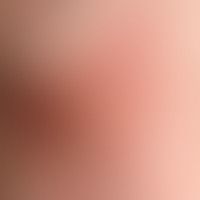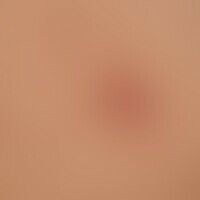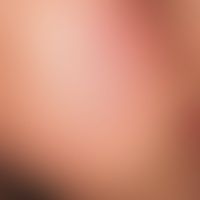Image diagnoses for "red"
876 results with 4456 images
Results forred

Squamous cell carcinoma of the skin C44.-
Squamous cell carcinoma of the skin: approx. 3 cm in diameter, coarse, crusty, exuding tumour with an inflammatory reddening of the edges in the area of the neck of a 95-year-old female patient, which empties purulent secretion under pressure.

Dermatitis herpetiformis L13.0
Dermatitis herpetiformis. grouped, urticarial papules with erosions and crusts of 2-4 mm in size on light to deep red erythema. in the centre smaller polygonal vesicles. the colourful juxtaposition of different efflorescences is characteristic of dermatitis herpetiformis.

Solar dermatitis L55.-
Dermatitis solaris: flat, sharply defined, painful erythema on the back, 10 hours after prolonged exposure to the sun.

Lichen simplex chronicus L28.0
Lichen simplex chronicus: chronic plaque consisting of peripherally disseminated, solid, red papules confluent in the centre of the lesion; intermittent itching leading to unsuppressible scratching

Netherton syndrome Q80.9
Netherton syndrome: clinical picture already manifested in childhood with the formation of large, also circulatory, garland-like, brown-red or red surface-rough, scaly plaques; numerous type I sensitizations.

Eyelid dermatitis (overview) H01.11
Chronic contact allergic eyelid dermatitis: therapy-resistant, chronic dermatitis of the eyelid, possibly caused by beta-blocker-containing eye drops (for glaucoma).

Folliculitis superficial L01.0
Folliculitis superficial: slightly painful, follicular (staphylogenic) pyoderma with central necrosis and severe perifollicular erythema.

Linear porokeratosis Q82.8
Porokeratosis linearis unilateralis: Multiple, chronically stationary, first appeared 2 years ago, since then persisting, on the lower abdomen half-sided localized, striped, 0.2-4.0 cm large, partly isolated, partly confluent to larger areas, brown, rough papules and plaques.

Atopic dermatitis (overview) L20.-
Generalized atopic eczema: Exacerbated, generalized seizure-like itchy dermatitis with multiple, chronically dynamic, symmetrical, blurred, red, rough, flat plaques as well as flat, dry scaling red spots in a 19-year-old female patient.

Stevens-johnson syndrome L51.1
Stevens-Johnson syndrome: acutely occurring vesicular exanthema with characteristic bull's-eye erythema, plaques and blisters as well as extensive, painful erosions of red lips, lip mucosa, tongue and gingiva in an 18-year-old woman. Clear general feeling of illness.

Erysipelas A46
Erysipelas, acute: under high fever, , within 2 days appeared, sharply limited flat, saturated redness and plaque formation of the left buttock. accompanying: painful regional lymphadenitis.

Lichen planus classic type L43.-
Lichen planus (classic type): itchy, polygonal, partially confluent, brownish-reddish papules on the right hand and right wrist of a 40-year-old man, existing for 8 weeks; independent of LP, strong, palmar hyperkeratoses exist, the development of which can be ascribed to the professional activity as floor layer.












